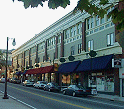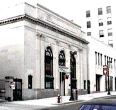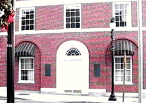 |
 |
Main Street
The heart of Woonsocket has always been the line of commercial buildings along Main Street. In the late nineteenth and early twentieth centuries, textile mills coexisted with banks, stores, hotels, theaters and churches making Main Street the social and commercial center of the city.
One Main Street
Lippitt Mill/Hanora Building
(1865)
Occupying a vital site at the intersection of Main Street and Market Square, the former Lippitt Mill office and warehouse sets the tone for the rest of Main Street. The 31/2 story, granite trimmed, mansard roofed building was built by the Lippitt Woolen Company in 1865 and was used in the production of woolen goods through the Second World War. In 1982, the building was converted into apartments as part of the Hanora Lippitt Manor complex.
10 -12 Main Street
The French Quarter
(1883)
This building has been beautifully updated and restored to include 3 store fronts on the Main Street level. The Legion Post which previously occupied Main Street will be shifted to the Arnold Street side of the building. The developer may also convert a long vacant hotel above the store fronts into apartments. 
15 Main Street
The Ballou-Harris-Lippitt Mills
(1836 incorporating an earlier brick mill of 1827)
The earliest section of this mill, built of brick in 1827, is now largely hidden by a 1836 addition. Erected by Dexter Ballou, the 1836 addition is built of stone with a brick cornice and wooden stair tower in the Greek Revival style. In front of this building, remnants of the 1827 Lyman Arnold trench can still be seen. This trench channeled water from the Woonsocket Falls to power the mills along Main Street. In 1982, the building was also converted to apartments as part of the Hanora Lippitt Manor complex.
32-34 Main Street
The Farrington Block
(1868)
This 4 story brick building was erected by Billings Farrington to house his jewelry and watchmaking business. The building was given architectural detail through the application of ornamental cast iron lintels on roundheaded windows.
55-69 Main Street
Buckland and Clark Building
(1897 incorporating and earlier mill building of 1846)
The rear 6 story section of this building was originally a woolen mill erected by Edward Harris in 1846. In front of it, built over the Lyman-Arnold Trench, is a block of stores originally known as the Buckland and Clark Building and later as Kornstein's. The building retains beautiful classical detail carried out in cooper on the second floor. 
75 Main Street
The Buell Building
(1922)
Newspapers have been an important factor in the social and commercial history of Woonsocket since the first newspaper - the Woonsocket Patriot - was established in 1833. That paper maintained almost undisputed control over Woonsocket until 1873 when a daily newspaper - the Evening Reporter - also began publishing. The Woonsocket Patriot merged with the Evening Reporter in 1881.
The predecessor of today's Woonsocket Call - the Evening Call - was founded in 1892 by a group of Woonsocket Democrats to counter the Republican tendances of the Evening Reporter. The Evening Call was a great success and acquired the Evening Reporter in 1895. Originally located in the Granite Building (previously the Harris Block and now City Hall), the Call purchased the Rescue Building in 1914 and renamed it the Buell Building in honor of one of its original owners. When fire destroyed that building in 1922, this building was constructed in its place.

93-119 Main Street
The Commercial Block
1902
Willis and Lyman Cook established the Woonsocket Foundry Company on this site in 1835. Later, the site was occupied by the American Worsted Company. The Commercial Block was constructed on this site in 1902. The long, three story, store and office block is treated above the store fronts as a series of major bays separated by pilasters in between which are rows of windows. While the second floor has been modernized, the third floor retains much of its period detail.
136-148 Main Street
Woonsocket Institute for Savings
(1926 and 1964)
The oldest savings bank in Woonsocket was the Woonsocket Institution for Savings which was incorporated in 1849. Its first President was Willis Cook. In 1875, Aram Pothier was offered a position at the Woonsocket Institution for Savings. He worked hard to learn all facets of the banking business becoming a teller in 1889, Vice President in 1909 and President in 1913. In 1926, the bank built this beautiful building on Main Street across from City Hall.
This one story, neoclassical building was constructed of Indiana limestone. In 1964, the bank expanded into the vacant Woolworth's store next door at 154-156 Main Street after Woolworth's moved to the Walnut Hill Plaza in East Woonsocket. The facade of that building was renovated and carefully scaled to relate to this building. Woonsocket Institute for Savings, later renamed Eastland Bank, moved to a new headquarters in the Social district in 1978. The bank was ultimately acquired by Fleet Bank.

141 Main Street
Former Old Colony Bank Building
(1937)
A simple and elegant neo-Federal style building which has been recently renovated and restored. 
164-168 Main Street
Rhode Island Hospital Trust Building
(1930)
Dedicated in 1930, this impressive building is a scaled down version of the Hospital Trust Building in Providence. For many decades, this was Woonsocket's tallest building. It was surpassed with the completion of the Marquette Credit Union Building in the Social district in 1975. Hospital Trust also moved to a new banking facility in the Social district in 1975. The Rhode Island Registry of Motor Vehicles currently occupies the building's beautiful banking lobby on the first floor.
169 Main Street
City Hall
(1856 and 1891)
The oldest section of this building was constructed by Edward Harris in 1856 and was known as the Harris Block. Built in the Italiante style, it was Woonsocket's first major commercial building and the first public library in Rhode Island. Abraham Lincoln spoke in the building's Harris Hall in 1860. In 1889, a rugged, granite clad addition in the Richardson Romanesque style was added. The building became Woonsocket's City Hall in 1902.Click here to continue your walk down Main Street.
This page utilizes information from:
- Statewide Historic Preservation Report for Woonsocket, Rhode Island published by the Rhode Island Historic Preservation Commission in September, 1976.
- Woonsocket, Rhode Island - A Centennial History 1888 - 1988 published by the Woonsocket Centennial Committee in 1988.
- Woonsocket Call, Main Street 2000 Development Corporation section, December 16, 1997
- History of Providence County Rhode Island edited by Richard M. Bayles and published by W. W. Peston & Co., New York, 1891
Main Street 2000 | Market Square | Main Street | Depot Square
Monument Square | Social | Historic Places
